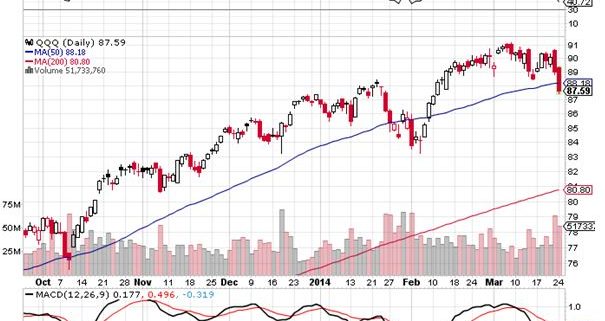I am writing this to you from the ancient city of Bodrum on the southwest coast of Turkey. Coming here, I had to set my watch ahead ten hours, then back 3,000 years.
As I sit here on my balcony, a flotilla of yachts, both large and small, motor by with the Greek island of Kos hovering in the background in the haze. Smoke from the gurgling water pipes below waft in my direction.
The carnage in Syria goes on 400 miles to my east and worse in Iraq another 300 miles in the distance. The security forces are on a nervous alert and machine guns held by jumpy, sweating teenagers are everywhere. My five star hotel is eerily vacant, even though it is peak season, but the service is great.
Despite these ominous signs, I am happy to report that the industry beating performance of the Mad Hedge Fund Trader?s Trade Alert Service has punched through to a new all time high.
The total return for my followers so far in 2014 has reached 19.74%, compared to a far more feeble 1.4% for the Dow Average during the same period. June came in at a robust 4.32%.
I managed to pull this off during some of the most difficult trading conditions in market history. Turnover across all asset classes is hitting decade lows (see chart below), and volatility has crashed through the floor. Most of the rest of the hedge fund industry is getting destroyed.
The three and a half year return is now at an amazing 142.24%, compared to a far more modest increase for the Dow Average during the same period of only 36%.
That brings my averaged annualized return up to 39.7%. Not bad in this zero interest rate world. It appears better to reach for capital gains than the paltry yields out there.
This has been the profit since my groundbreaking trade mentoring service was first launched in 2010. Thousands of followers now earn a full time living solely from my Trade Alerts, a development of which I am immensely proud of.
Like most of the industry, I expected May and June to be poor months for risk assets. The market has had a tremendous run over the last two years, and the spring historically heralds a period of seasonal weakness.
Wrong!
One of the toughest things to do in this business is to admit you blew it, and then execute an immediate risk reversal in your portfolio.
In the end, the failure of the market to fall meant that it could only go up. We got additional help from month end window dressing, calming events in the Ukraine, and a 7:1 share split at Apple.
Another particularly vexing challenge is that the principal market driver has shifted from economics to geopolitics. The global economic recovery continues, but at a pace so modest that it hardly moves the needle on the volatility front.
The world is waiting to see whether the US can deliver a second half GDP growth rate of 4% per annum?.. or not.
In the meantime, a megalomaniac in Russia and terrorists in the Middle East are determining the short-term direction of asset prices. No hedge fund trader has any edge here, so calls on the coming price action are little more than educated guesses and wishing.
Good luck outperforming in that environment!
I played June predominantly from the long side, accumulating a basket of positions in old technology and traditional industrial names like IBM (IBM), Google (GOOGL), Caterpillar (CAT), and Microsoft (MSFT). I then opportunistically laid out hedging shorts in the S&P 500 (SPY) and the Treasury bond market (TLT).
As the market has tortuously ground up, I have whittled back my portfolio. I figured out that the way to make money trading in this market was not to trade, to ignore the day-to-day counter trend moves.
As a result, almost every day in June was profitable for my followers.
Quite a few were able to move fast enough to cash in on the move. To read the plaudits yourself, please go to my Testimonials Page . They are all real, and new ones come in almost every day.
My esteemed colleague, Mad Day Trader Jim Parker, was no slouch either, dodging in an out of the raindrops to make money on an intraday basis.
What would you expect with a combined 85 years of market experience between the two of us? Followers are laughing all the way to the bank.
Don?t forget that Jim clocked an amazing 2013 with a staggering 374% trading profit. That was just for an eight-month year!
The Opening Bell with Jim Parker, a quickie but insightful webinar giving followers an instant snapshot of the market opening every day, has been an overwhelming success. Many customers have already reported dramatic improvements in their trading results.
Watch this space, because the crack team at Mad Hedge Fund Trader has more new products and services cooking in the oven. You?ll hear about them as soon as they are out of beta testing.
Our business is booming, so I am plowing profits back in to enhance our added value for you. Next out will be the Mad Hedge Fund Trader Channel on YouTube that will enable me to post videos from my frequent travels around the world.
The coming year promises to deliver a harvest of new trading opportunities. The big driver will be a global synchronized recovery that promises to drive markets into the stratosphere by the end of 2014.
Global Trading Dispatch, my highly innovative and successful trade-mentoring program, earned a net return for readers of 40.17% in 2011, 14.87% in 2012, and 67.45% in 2013.
Our flagship product,?Mad Hedge Fund Trader PRO, costs $4,500 a year. It includes my Global Trading Dispatch?(my trade alert service and daily newsletter). You get a real-time trading portfolio, an enormous research database, and live biweekly strategy webinars. You also get Jim Parker?s?Mad Day Trader?service and?The Opening Bell with Jim Parker.
To subscribe, please go to my website at?www.madhedgefundtrader.com, find the?Global Trading Dispatch??or ?Mad Hedge Fund Trader PRO??box on the right, and click on the blue??SUBSCRIBE NOW??button.



































































